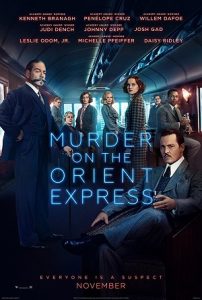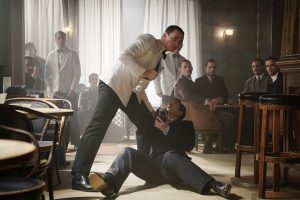 The film making process sucks, particularly when shooting on location. There are so many things that can and will go wrong, and even the most organized production is a logistical nightmare. So when mounting an adaptation of Agatha Christie’s “Murder on the Orient Express” – a novel that yielded a film version by Sidney Lumet in 1974 that most would agree is difficult to improve upon – it means hauling a sizeable cast and crew into the snowy mountains of Vinkovci, and contending with all manner of weather, terrain, unavailable shelter, and unreasonable demands from pampered Hollywood actors. However, we now inhabit a digital age in which such perilous expeditions are no longer a necessity; thanks to an army of craftsmen, any environment can be duplicated on a soundstage. Just set up your green screen, paint in some treacherous-looking environments with your computer, and voila! Just ask George Lucas, who not only pioneered the technology, and who shot most of his prequel trilogy from the comfort of a chair.
The film making process sucks, particularly when shooting on location. There are so many things that can and will go wrong, and even the most organized production is a logistical nightmare. So when mounting an adaptation of Agatha Christie’s “Murder on the Orient Express” – a novel that yielded a film version by Sidney Lumet in 1974 that most would agree is difficult to improve upon – it means hauling a sizeable cast and crew into the snowy mountains of Vinkovci, and contending with all manner of weather, terrain, unavailable shelter, and unreasonable demands from pampered Hollywood actors. However, we now inhabit a digital age in which such perilous expeditions are no longer a necessity; thanks to an army of craftsmen, any environment can be duplicated on a soundstage. Just set up your green screen, paint in some treacherous-looking environments with your computer, and voila! Just ask George Lucas, who not only pioneered the technology, and who shot most of his prequel trilogy from the comfort of a chair.
The problem is, it looks fake, because it is. And it kills suspension of disbelief as effectively as an assassin creeping through a train cabin during the wee hours of morning; because after all, how can one possibly buy into the illusion of a group of people standing on a snowy precipice with howling wind when their faces are free of redness, dripping snot, or frosty breath…? One can almost smell the craft services located on the other side of the room that’s standing in for a cliff.
 But that’s just how films are made now. There is an artificiality that prevents full emersion. Director Kenneth Branagh does his usual double-duty both behind and in front of the camera, inheriting the role of idiosyncratic detective Hercule Poirot from such luminaries as Albert Finney, Peter Ustinov, and David Suchet; yet for all the gritty immediacy of his Shakespearian adaptations, he’s now a part of the machine. This was first apparent in his take on “Thor,” in which a director best known for nurturing the subtlety and pyrotechnics of dialogue and interpersonal communication, was suddenly framing his story in shots designed specifically for a 3-D experience. Time marches on, and directors must change, or perish.
But that’s just how films are made now. There is an artificiality that prevents full emersion. Director Kenneth Branagh does his usual double-duty both behind and in front of the camera, inheriting the role of idiosyncratic detective Hercule Poirot from such luminaries as Albert Finney, Peter Ustinov, and David Suchet; yet for all the gritty immediacy of his Shakespearian adaptations, he’s now a part of the machine. This was first apparent in his take on “Thor,” in which a director best known for nurturing the subtlety and pyrotechnics of dialogue and interpersonal communication, was suddenly framing his story in shots designed specifically for a 3-D experience. Time marches on, and directors must change, or perish.
It’s unfortunate that such artifice is so overused in this film, because otherwise, “Murder on the Orient Express” works. Following in the tradition of Poirot’s cinematic adventures during the 70s and 80s, Branagh has crafted a lavish picture bursting with recognizable faces from both past and present, with a welcome touch of Cole Porter to interrupt Patrick Doyle’s lovely, if not particularly memorable, score. We are given a cast of characters stuck in a landlocked train, and a dead asshole (Johnny Depp) that one of the passengers has stabbed twelve times in his bed. Is the killer button-nosed Daisy Ridley? Austrian racist Willem DaFoe? Religious zealot Penelope Cruz? Used-up gold-digger Michelle Pfeiffer? Dame Judy Dench? Derek Jacobi? Leslie Odom, Jr.? Or the annoying Josh Gad, who, ironically, gives the first performance in his career where we aren’t asking for him to be the one thrust repeatedly with a sharp blade? Which of the assembled cast of recognizable faces perpetrated this heinous crime, and when will he or she strike next? Can Poirot solve an unsolvable crime before help arrives and the passengers are rescued from their dangerous mountain perch?

Then answer is, of course, what “Murder on the Orient Express” is best known for: it’s ending isn’t one to have spoiled for you before seeing either film version. It’s a twist unlike any other in the detective genre, and one that pays off everything the narrative has built in its quest to reach it. While Lumet’s take on the final revelation is more visceral, Branagh wisely reinterprets rather than imitate, and delivers unexpected emotion and heartache to the payoff.
While in no way an improvement on the 1974 version, the 2017 “Murder on the Orient Express” is a return to classic Hollywood filmmaking, digital annoyances notwithstanding. The concept of a prestige film utilizing an ensemble of character actors playing, in many cases, against type, is a welcome thing, particularly given the strength of the source material and the obvious devotion to the intended nostalgic quality of presentation. It’s still a 2017 take, though, meaning Poirot has an out-of-place fight scene while dangling from the scaffolding of the train bridge; while it doesn’t ruin the film, it still feels like you’re watching an executive’s yellow sticky note brought to life. But, hey: that’s just how movies are now, and you can hardly fault a film for these flaws when it’s so obviously trying to remind us what the theatrical experience used to be.
Directed by Kenneth Branagh
Written by Michael Green
Rated PG-13 for violence and thematic elements



Leave a Reply
You must be logged in to post a comment.